Jam, jelly and relish, 175pp.
by Ghillie James
Kyle Books, Lanham Maryland, 2010
Cooking on page 132–33
Our backyard is loaded with fruit trees and I’ve made desserts, as well as countless jars of jams, preserves and fruit leathers.
Two decades ago I made a quadruple batch of quince leather. Quince is a tough fruit to work with, and I was especially proud to have 16 trays of quince paste drying in the sun. Of course, later that afternoon, while I was running errands, the city got hit by a freak thunderstorm, so you know what happened to that effort. 😦
Funnily enough, this book doesn’t have any recipes for quinces, but page 132–33 has a recipe for one of Poor John’s very favourite foods—Seville marmalade.
I’ve also added a second marmalade recipe. It’s not from a page 32, but is a favourite from my friend Lyn. She often gives a jar of this to Poor John, It’s from Stephanie Alexander’s classic, The cook’s companion. I’ve already made a page-32 recipe from that book—the divine gratin of mussels.
Easy Seville marmalade (first recipe)
Ingredients
2lb (1kg) Seville oranges
3½ cups packed dark brown sugar
5 cups granulated sugar
juice of 1 large lemon
Method
Wash the oranges thoroughly, then remove the knobby bits from the ends and cut each in half. Thoroughly juice the oranges (I use an electric juicer). Discard the seeds and pour the juice into a large bowl. Cut the juiced halved oranges in half again and remove and remaining seeds. Put the quarters into a food processor and process until finely chopped (you might need to do this in two batches), or cut the peel into shreds by hand. Add the chopped flesh, peel and pith to the juice in the bowl and pour in 2½ quarts (2.5 litres) of cold water. Stir, cover and leave to macerate overnight.
The next day, transfer everything into a large pan and bring to a boil (this will take about 15 minutes). Once at boiling point, reduce the heat and simmer for another 1½ hours, or until the peel is soft.
Add the sugars and lemon juice and stir over the heat until the sugar has dissolved. Increase the heat to bring the liquid to a rolling boil. Do not stir the marmalade from this point on. After 20 minutes, test to see if it has reached setting point. If it hasn’t, leave for another few minutes, then test again.
Remove the pan from the heat, leave to stand for 10 minutes, then ladle the marmalade, or pour it from a pitcher, into sterilized jars and seal.
Seville marmalade (second recipe)
Ingredients
Seville orange, water, salt, sugar
Method
Thinly slice fruit, having first removed all pips and central membranes. For every 500 g prepared fruit, allow 1.8 litres water and ¼ teaspoon salt. Simmer fruit, salt and water until peel is soft and easily squashed. Allow to rest 24 hours in a ceramic or stainless steel bowl.
Next day, measure fruit and water into a preserving pan or large stockpot using a cup. Bring to a boil and for every cup of fruit and water allow an equal measure of sugar. Return to a boil and cook for 25–30 minutes until setting or jelly stage. Bottle into hot, sterilised jars.
How it played out
Seville oranges were on special at the market a little while back—$4 a kilo. I called Poor John at home and asked him if I should buy some. Oh no, I don’t want you to go to all that trouble.
Good grief, I already had the cookbook and two recipes in mind, so I bought 2 kilos anyway. Glad I did because it was the only time this season that I saw them in the markets.
So on to the recipes. By the way, I used a kilo of fruit for each.
I made both recipes as written, but started them two days apart, so I could avoid having a juggling act in the kitchen.
I hand squeezed the oranges for the first recipe and used the food processor to chop the squeezed quarters. It took an extra 10 minutes of cooking to get the marmalade to set, and in the process in burned slightly on to the bottom of the pan. The resulting marmalade was quite dark and almost impossible to photograph.
The second recipe set within the 30 minutes suggested for the last cooking time.
All the photos here are of the first recipe, except for the main pic of the bottled marmalade and the pic of the marmalade on toast. I simply could not get decent pics of the first batch.
Verdict
Both marmalades tasted great, but in future I’ll use the second recipe. Poor John preferred the taste, plus it involved slightly less handling, cooked more reliably and looked deliciously like a jewel in a bottle.
This version is pretty enough to give as a gift!

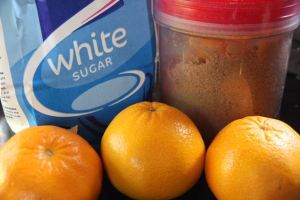


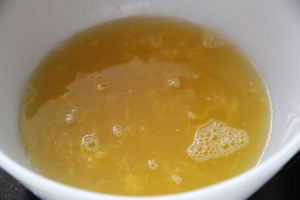
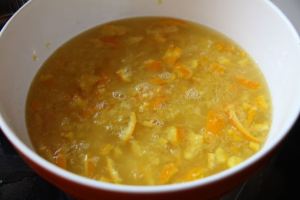
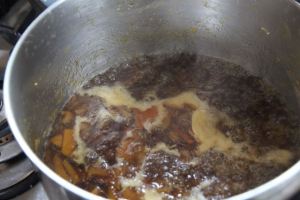
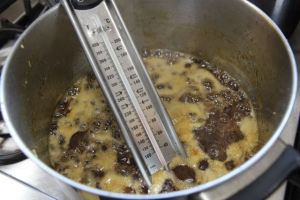
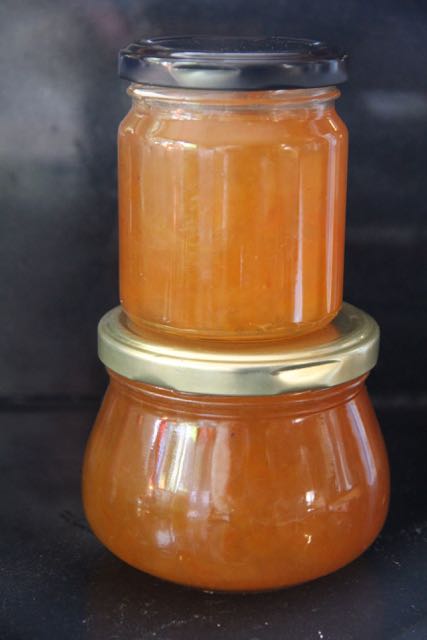
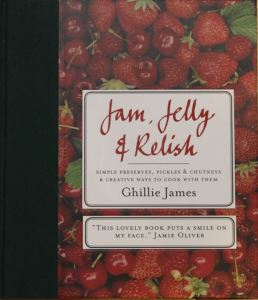
A jewel in a bottle – and a delicious looking one at that! I love marmalade but have never heard of Seville oranges. I’m also not an adventurous cook, but this does sound tasty. Might have to track down some marmalade from the store. Yum!
Poor John is the real marmalade lover in the family, and Seville marmalade is the most bitter version. If you try making marmalade, the second recipe here is super easy to make. If you are interested, I have a great recipe for lime marmalade—my favourite.
My mother used to make a version that included a grapefruit (prepared the same as the orange) that was quite tasty. It may have been a recipe that required a lemon that she didn’t have at the time. She was pretty clever when it came to making things with what was on hand.
Mothers are clever economisers. I have a grapefruit tree in the backyard, and love eating it fresh. Also have two lemon trees. The neighbours are keen for me to make their grapefruit marmalade recipe. Maybe next crop.
Yum!!! Grapefruit is my favorite citrus fruit, and I’d overdose on vitamin C if I had a grapefruit tree in my backyard!
I love grapefruit too. The taste of our fruit depends on rainfall, and the wetter the better. We’ve had great crops the last two years. I’ll post a pic one day.
Hi leggypeggy. I was wondering if your neighbours would be keen to share their grapefruit marmalade recipe? I’m on the hunt for a good one 🙂
Sure Marion. Here it is:
4 pounds grapefruit
8 pints water
12 pounds sugar
Cut fruit in quarters. Remove seeds and white centres. Slice fruit finely.
Put pips and centres in basin with a little of the water and stand 24 hours.
Next day, pour off water from pips and add to rest of fruit that has soaked overnight in remaining water.
Put in pan. Boil 1 hour, add sugar and boil 1 hour longer, until set.
Three-quarters of an hour may be enough.
Juice of a lemon aids setting.
No time and space for marmalade cooking. We just enjoy the andalusian oranges as juice for breakfast. Greetings from Spain
That’s a perfect way to enjoy the andalusian oranges. Lucky you.
That’s awesome you have so many fruit trees. The marmalade looks yummy!
Thanks. I feel very blessed to have so much bounty in my own garden.
Looks pretty easy and very good!
Thanks. It is easy and delicious.
Looks really good. Great because I currently have oranges in my house. Delicious! Thank you!😊😊
Thanks so much.
Your welcome 🙂🙂
By the way, we are home from our travels in India now and I tried to visit your blog. It isn’t there anymore. Do you have a new url?
Absolutely gorgeous!
Thanks. I thought the finished marmalade was especially beautiful.
🙂
I worship a good orange marmalade, so the prospect of a Seville marmalade has me all tingly. (And the fact that Poor John has an affinity for such makes him right as rain in my book…)
Worship is the perfect word to describe your and Poor John’s love of marmalade. You two would get on perfectly.